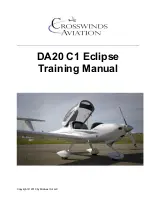
(3) Defuel airplane. Then open all fuel drains until all remain-
ing fuel is drained. Operate engine on each tank until all
undrainable fuel is used and engine stops. Then add the
unusable fuel (2.0 gallons total, 1.0 gallon each wing).
CAUTION
Whenever the fuel system is completely drained
and fuel is replenished, it will be necessary to
run the engine for a minimum of three minutes
at 1000 RPM on each tank to insure no air exists
in the fuel supply lines.
(4) Fill with oil to full capacity.
(5) Place pilot and copilot seats in fourth (4th) notch, aft of
forward position. Put flaps in fully retracted position
and all control surfaces in the neutral position. Tow bar
should be in the proper location and all entrance and
baggage doors should be closed.
(6) Weigh the airplane inside a closed building to prevent errors
in the scale readings due to wind.
(b) Leveling
(1) With airplane on scales, block main gear oleo pistons in the
fully extended position.
(2) Level airplane (refer to Figure 6-3) by deflating the nose
wheel tire to center bubble on level.
(3) Defuel airplane. Then open all fuel drains until all remain-
ing fuel is drained. Operate engine on each tank until all
undrainable fuel is used and engine stops. Then add the
unusable fuel (2.0 gallons total, 1.0 gallon each wing).
CAUTION
Whenever the fuel system is completely drained
and fuel is replenished, it will be necessary to
run the engine for a minimum of three minutes
at 1000 RPM on each tank to insure no air exists
in the fuel supply lines.
(4) Fill with oil to full capacity.
(5) Place pilot and copilot seats in fourth (4th) notch, aft of
forward position. Put flaps in fully retracted position
and all control surfaces in the neutral position. Tow bar
should be in the proper location and all entrance and
baggage doors should be closed.
(6) Weigh the airplane inside a closed building to prevent errors
in the scale readings due to wind.
(b) Leveling
(1) With airplane on scales, block main gear oleo pistons in the
fully extended position.
(2) Level airplane (refer to Figure 6-3) by deflating the nose
wheel tire to center bubble on level.
PIPER AIRCRAFT CORPORATION
SECTION 6
PA-28-161, WARRIOR III
WEIGHT AND BALANCE
PIPER AIRCRAFT CORPORATION
SECTION 6
PA-28-161, WARRIOR III
WEIGHT AND BALANCE
ISSUED: JULY 1, 1994
REPORT: VB-1565
6-3
ISSUED: JULY 1, 1994
REPORT: VB-1565
6-3
Summary of Contents for WARRIOR III PA-28-161
Page 8: ...THIS PAGE INTENTIONALLY LEFT BLANK REPORT VB 1565 viii ...
Page 10: ...REPORT VB 1565 1 ii THIS PAGE INTENTIONALLY LEFT BLANK ...
Page 22: ...REPORT VB 1565 2 ii THIS PAGE INTENTIONALLY LEFT BLANK ...
Page 80: ...REPORT VB 1565 5 ii THIS PAGE INTENTIONALLY LEFT BLANK ...
Page 114: ...REPORT VB 1565 6 ii THIS PAGE INTENTIONALLY LEFT BLANK ...
Page 130: ...REPORT VB 1565 7 ii THIS PAGE INTENTIONALLY LEFT BLANK ...
Page 156: ...REPORT VB 1565 8 ii THIS PAGE INTENTIONALLY LEFT BLANK ...
Page 178: ...REPORT VB 1565 9 ii THIS PAGE INTENTIONALLY LEFT BLANK ...
Page 188: ...REPORT VB 1565 10 ii THIS PAGE INTENTIONALLY LEFT BLANK ...












































